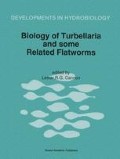Abstract
In spiralian embyros determination of the axes of bilateral symmetry is associated with D quadrant specification. This can occur late through equal cleavage and cell interactions (conditional specification) or by the four-cell stage through unequal cleavage and cytoplasmic localization (autonomous specification). Freeman & Lundelius (1992) suggest that in spiralian coelomates the former method is ancestral and the latter derived, with evolutionary pressure to shorten metamorphosis resulting in early D quadrant determination through unequal cleavage and appearance of adult features in the larvae. Because of the key phylogenetic position of the turbellarian platyhelminthes, understanding the method of axis specification in this group is important in evaluating the hypothesis. Polyclad development, with equal quartet spiral cleavage, is believed to represent the most primitive condition among living turbellarians and has been examined experimentally in Hoploplana inquilina. Blastomere deletions at the two and four-cell stage produce larvae that are abnormal in morphology and symmetry, indicating that early development is not regulative, and also establish that the embryo does not have an invariant cell lineage. Deletions of micromeres and macromeres at the eight-cell stage indicate that cell interactions are involved in dorso-ventral axis determination, with cross-furrow macromeres playing a more significant role than non-cross-furrow cells. The results support the idea that conditional specification is the primitive developmental mode that characterized the common ancestor of the turbellarians and spiralian coelomates. Evolutionary trends in development in polyclads and other turbellarian orders are discussed.
Access this chapter
Tax calculation will be finalised at checkout
Purchases are for personal use only
Preview
Unable to display preview. Download preview PDF.
References
Baguñà, J. & B. C. Boyer, 1990. Descriptive and experimental embryology of the Turbellaria: Present knowledge, open questions and future trends. In H. Marthy (ed.), Experimental Embryology in Aquatic Plants and Animals, NATO ASI Series A: 195: 95–128.
Beauchamp, P. de, 1961. Classe des Turbellaries. In P. P. Grasse (ed.), Traite de Zoologie, IV. Masson, Paris: 35–212.
Boyer, B. C., 1971. Regulative development in a spiralian embryo as shown by cell deletion experiments on the acoel Childia. J. exp. Zool. 176: 96–105.
Boyer, B. C., 1986a. Experimental evidence for the origins of determinative development in the polyclad Turbellaria. Hydrobiologia 132 (Dev. Hydrobiol. 32): 117–119.
Boyer, B. C., 1986b. Determinative development in the polyclad turbellarian Hoploplana inquilina. Int. J. invert. Repro. Dev. 9: 243–251.
Boyer, B. C., 1987. Development of in vitro fertilized embryos of the polyclad flatworm Hoploplana inquilina following blastomere separation and deletion. Roux’s Arch. dev. Biol. 196: 158–164.
Boyer, B. C., 1988. The effect of removing vegetal cytoplasm during the maturation divisions on the development of Hoploplana inquilina (Turbellaria, Polycladida). Fortschr. Zool. 36: 277–282.
Boyer, B. C., 1989. The role of the first quartet micromeres in the development of the polyclad Hoploplana inquilina. Biol. Bull. 177: 338–343.
Boyer, B. C., 1992. The effect of deleting opposite first quartet micromeres on the development of the polyclad Hoploplana. Biol. Bull. 183: 374–375.
Christensen, D. J., 1971. Early development and chromosome number of the polyclad flatworm Euplana gracilis. Trans. am. microsc. Soc. 90: 457–463.
Davidson, E. H., 1991. Spatial mechanisms of gene regulation in metazoan embryos. Development 113: 1–26.
Freeman, G. & J. W. Lundelius, 1992. Evolutionary implications of the mode of D quadrant specification in coelomates with spiral cleavage. J. evol. Biol. 5: 205–247.
Galleni, L. & V. Gremigni, 1989. Platyhelminthes-Turbellaria. In K. G. Adiyodi & R. G. Adiyodi (eds), Reproductive Biology of Invertebrates, IV. J. Wiley & Sons, N.Y.: 63–89.
Giesa, S., 1966. Die Embryonalentwicklung von Monocelis fusca Oersted (Turbellaria, Proseriata). Z. Morph. Okol. Tiere 57: 137–230.
Kato, K., 1940. On the development of some Japanese polyclads. Jap. J. Zool. 8: 537–573.
Martindale, M. Q., C. Q Doe & J. B. Morrill, 1985. The role of animal-vegetal interaction with respect to the determination of dorsoventral polarity in the equal cleaving spiralian, Lytnnaea palustris. Roux’s Arch. dev. Biol. 194: 281–295.
Raff, R. A. & R. C. Kaufman, 1983. Embryos, Genes and Evolution. Macmillan Publishing Co., Inc., New York, 395 pp.
Reisinger, E., 1970. Zur Problematik der Evolution der Coelomaten. Z. zool. Syst. Evolut-forsch 8: 81–109.
Reisinger, E., I. Cichocki, T. Erlach, & T. Szyskowitz, 1974a. Ontogenetische Studien an Turbellarien: ein Beitrag zur Evolution der Dotterverarbeitung im ektolecitalen Ei. I. Z. zool. Syst. Evolut.forsch. 12: 161–195.
Reisinger, E., I. Cichocki, T. Erlach, & T. Szyskowitz, 1974b. Ontogenetische Studien an Turbellarien: ein Beitrag zur Evolution der Dotterverarbeitung im ektolecitalen Ei. II. Z. zool. Syst. Evolut.forsch. 12: 241–278.
Rho, S., 1976. Studies o:n the polyclad Turbellaria of Korea 11. Spawning and early development of Stylochus ijitnai Yen et Katuraki and Pseudostylochus sp. under laboratory conditions. Bull. Fish. Res. Dev. Agency 15: 125–140.
Surface, F. M., 1907. The early development of a polyclad, Planocera inquilina. Proc. Acad. nat. Sci. Philad. 59: 514–559.
Teshirogi, W., S. Ishida & K. Jatani, 1981. On the early development of some Japanese polyclads. Rep. Fukaura mar. biol. Lab. 9: 2–31.
Thomas, M. B., 1986. Embryology of the Turbellaria and its phylogenetic significance. Hydrobiologia 132 (Dev. Hydrobiol. 32): 105–115.
van Dam, W. I. & N. H. Verdonk, 1982. The morphogenetic significance of the first quartet micromeres for the development of the snail Bithyniatentaculata. Roux’s Arch. dev. Biol. 191: 112–118.
van den Biggelaar, J. A. M. & P. Guerrier, 1979. Dorsoventral polarity and mesentoblast determination as concomitant results of cellular interactions in the mollusk Patella vulgata. Dev. Biol. 68: 462–471.
Author information
Authors and Affiliations
Editor information
Editors and Affiliations
Rights and permissions
Copyright information
© 1995 Springer Science+Business Media Dordrecht
About this paper
Cite this paper
Boyer, B.C. (1995). What studies of turbellarian embryos can tell us about the evolution of developmental mechanisms. In: Cannon, L.R.G. (eds) Biology of Turbellaria and some Related Flatworms. Developments in Hydrobiology, vol 108. Springer, Dordrecht. https://doi.org/10.1007/978-94-011-0045-8_37
Download citation
DOI: https://doi.org/10.1007/978-94-011-0045-8_37
Publisher Name: Springer, Dordrecht
Print ISBN: 978-94-010-4025-9
Online ISBN: 978-94-011-0045-8
eBook Packages: Springer Book Archive

